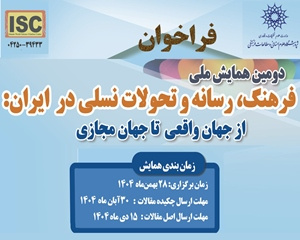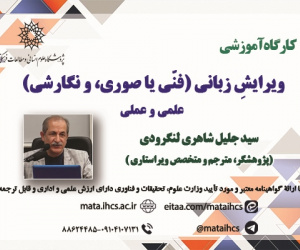نقد و نظری بر مثنوی معنوی تصحیح استاد محمدعلی موحد (مقاله علمی وزارت علوم)
درجه علمی: نشریه علمی (وزارت علوم)
آرشیو
چکیده
در میان تصحیح های پرشمار مثنوی معنوی، چاپ استاد محمدعلی موحد، آخرین و بی گمان برترین است. در این مقاله این اثر فاخر را، ضمن برشمردن مزیت های آن، در چهار محور ارزیابی کرده ایم: 1) تصحیح ابیات: در این بخش 14 مورد که عمدتاً به معنی و گاه به اعتبار ابیات درج شده از هامش نسخه ها مربوط اند بررسی شده است؛ 2) فاصله گذاری میان ابیات مثنوی: این کار به زعم نگارنده از مزیت های این چاپ و از لوازم برقراری ارتباط آسان تر خواننده امروزی با مثنوی است. در این بخش سیاست گذاری مصحح دانشمند در اعمال فاصله ها ارزیابی شده است؛ 3) رسم الخط: به زعم نگارنده، اتخاذ رسم الخط اندیشیده و یکدست در تصحیح متون، برمبنای آنچه فرهنگستان زبان فارسی تعیین کرده است، هم دستگیر خواننده در درست خوانی است و هم چاپ های متون کهن را از آشفتگی می رهاند. بعضی اشتباهات راه یافته در حروف چینی و عدم اتخاذ وحدت رویّه، ایرادهایی در چاپ استاد راه داده که ارتباط خواننده را با معنای اثر دشوار کرده است؛ 4) کاربرد نشانه های سجاوندی: در چاپ استاد به کارگیری نشانه ها، بدون افراط های معمول، نظرگیر است. در این مبحث، ضمن نشان دادن دقت های استاد، به اختصار، کاربرد نشانه ویرگول را بررسیده و به ذکر مواردی پرداخته ایم که ویرگول معنای بیتی را محدود کرده، یا خدشه ای به آن راه داده است. برای پرهیز از طول کلام، فقط دفتر اول مثنوی را مورد بررسی قرار داده ایم.A Critical Review on the Mathnavī-ye- Manavī Edited by M. A. Movahhed
Among the numerous corrections of the spiritual Mathnavi, the edition of Mohammad Ali Movahhed is the last and without a doubt the best. More than four years have passed since the first edition of this work, which has now reached its third edition. The professor has put corrections on eight complete and monograph versions, all belonging to a maximum of fifteen years after Rumi's death, and three other auxiliary versions. Of these, seven copies were probably written under the supervision of Hossam al-Din Chalabi, the last caliph, and Sultanwaleed, the son of Maulana. Of the other three versions, two versions were written during the lifetime of Sultan Vold. In this article, we have evaluated this magnificent work, while enumerating its advantages, in the following four areas: 1) Correction and recording of verses: In this section, due to the avoidance of word length, we have only discussed the correction of a number of verses in the first book. In order to understand the meaning of some verses according to their recording, because the professor did not say anything in the correction of the book (and we hope that they will clarify the point in the annotations or commentary of the Masnavi later), we have no choice but to speculate. The priority of recording some verses or some words in Masnavi verses, considering the possibility of different readings in the recording of words and combinations such as Bad/Yad, Karkan/Karn, Kardi/Gardi, forms the main topics of this part of the article. In this section, we have reviewed 14 examples, which are mainly related to the meaning and sometimes the validity of the verses included in the margins of the versions. 2) Spacing between the verses of the Masnavi: One of the interesting features of this correction is the spacing between the verses throughout the Masnavi. What obligates this work is the most obvious characteristic of Masnavi in telling stories and parables, which, apparently, is the horizontal line of travel And they are not straightforward. The professor listed three goals for these intervals: 1- to guide the reader in the content; 2- Preventing the possible boredom of the singer due to the repetition of monotony and continuity on a single song; 3- Paying attention to the turn of Rumi's words according to the situations of the narration and reflecting on his narrow thoughts. (Rek: Molana, 1396, vol. 1, introduction: one hundred and fifty-five). The author considers spacing between the verses of the Masnavi useful and worthy of appreciation due to the possibility of easier communication of the modern reader with this text. According to the author, out of the three goals that Professor Mowahed has set the foundation of spacing on, the second goal, especially with the clause "probable boredom of the reader", is not very evaluable, because in fact it is not known which reader gets bored where. Therefore, in this part of the article, we have examined and analyzed the first and third reasons, which are responsible for the plot of Rumi's continuous twists and turns from the straight line of the speech, and we have shown that in some cases, the application of scholarly correct spacing may not be justified. 3) Script: Although the Persian Language Academy has made efforts to organize the Persian script for many years, among the high-quality corrections and numerous editions of ancient texts, one can find less evidence that the correctors have a single policy in writing all kinds of Persian words throughout the text. Applying a single policy to distinguish word types, especially in rhymed texts, can guide readers to "correct reading". Even though Professor Mowahed did not use a single procedure in writing in this correction, his precision in calligraphy is noticeable. According to the author, adopting a well-thought-out and uniform script in the correction of texts, based on what has been determined by the Persian Language Academy, both arrests the reader in correct reading and frees the pr



